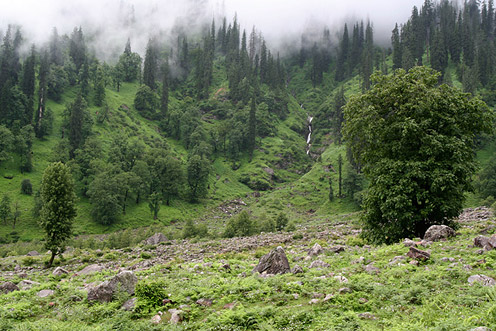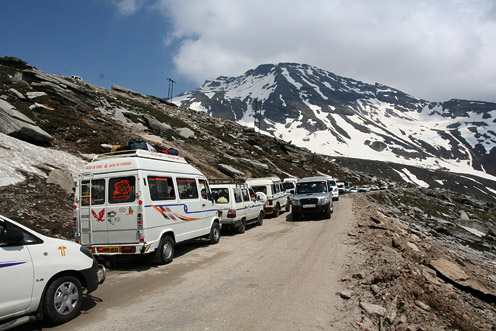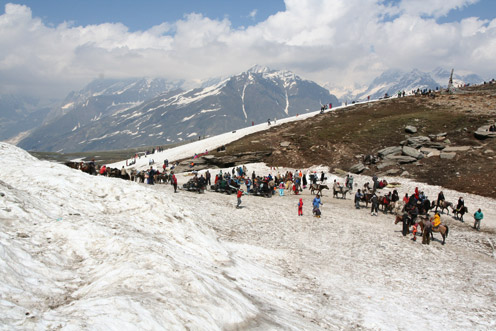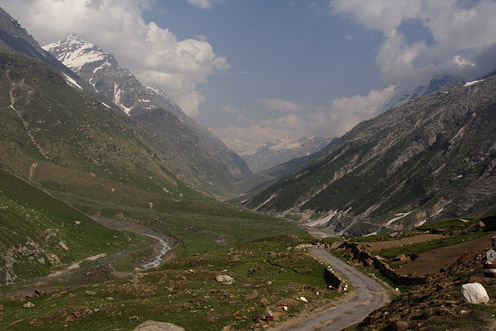Ladakh – The complete guide to Leh – Manali Road – II
Manali to Rohtang Pass
People start from Manali at an unearthly hour of 2am. And they keep going and going and going, travelling nearly twenty hours to get to Leh. It seems like a senseless adventure to go in a cramped Tata Sumo in those testing altitudes; It seems like Leh will never come. But people do it: many Sumos leave for Leh everyday, packing passengers from Manali who don’t want to waste a day or spend more money by stopping on the way.

Verdant landscapes of Beas Valley
The initial part of the journey is pleasant. The road runs upstream of Beas River through a green valley, with tall mountains on both sides flaunting coniferous forests on their slopes. It slopes up gently for the first half hour and then steadily increases in gradient. Waterfalls run abundant on the near vertical slopes, emerging out of the snow trapped in depressions. The sheer scale of mountains in these parts are realized by tiny specs of shepherd-tents that look no bigger than a small dot on the slopes. It indeed needs no less than a collision between two continental masses to create formations of this scale and might. Its grandeur, size and fearsome weather can overwhelms the onlooker and instantly earn his or her respect.
The slopes of Manali-Rohtang Pass road remain green through the year in lower regions. The deodar forests give way to shorter vegetation higher up, and eventually it is just green grass spreading thinly on the surface. Streams run all over the place uncontrolled, released from the melting masses of ice. The pass is completely covered in snow in early summer and gradually melts away, with very little of it left when the monsoons arrive. As the first rains come in and snow is drained out from the higher regions, flowers burst out on the slopes, filling up every inch of the mountains with tiny dots of pink and yellow.

The road to Rohtang Pass (File Photo)
The last hour of the journey though, is much more than the romance with the mountain ranges. The rush of tourists in search of snow creates frequent traffic jams on the way up. Unmetalled surface can be slushy and hard to navigate. The thin mountain air and the half burnt diesel emissions from the pile of vehicle heading up is not exactly pleasant. It looks no different from peak hour traffic in congested roads of our cities, save for the views of the mountains here.
Tourists at Rohtang Pass (File Photo)
In summer months when there is still snow, Rohtang attracts large crowds excited about the snow. It’s a mad tourist trap that takes in thousands of people, followed by hundreds of vendors trying to keep the tourists comfortable and happy. The plateau on the pass turns into a big market place with long lines of shacks selling things from Aloo Paratha to skiing lessons. But later in the season when the slopes are bare (this is when the Ladakh season begins, in late June), there are just a handful of optimistic tourists searching for last of the snow.
Beyond Rohtang: Chandra Valley in Lahaul (File Photo)
However, there is a sea change in atmosphere on getting past Rohtang and entering into the valley of Chandra river in Lahaul region. The greenery that kept comapny disappears suddenly and the slopes appear brown and arid. Dhauladhar mountains (the mountain range that hosts Rohtang Pass) keep the monsoon at bay, allowing little precipitation and extending the summer days until October. The mass of tourists, the traffic and commotion dies down and makes way to silence. Verdant landscapes of Beas Valley make way to a stark beauty that has no parallels to scenery witnessed so far. It is here that the traveller begins to see first glimpses of barren landscape that Ladakh is, though Ladakh itself is still far away.

